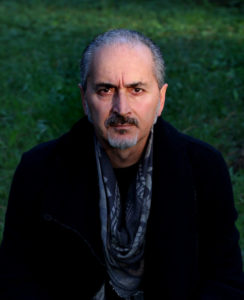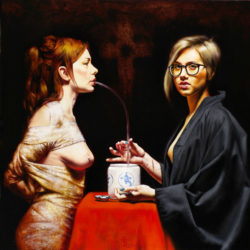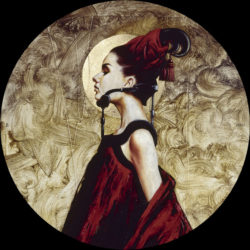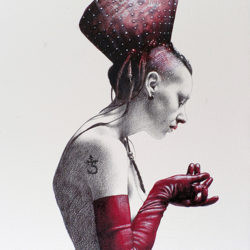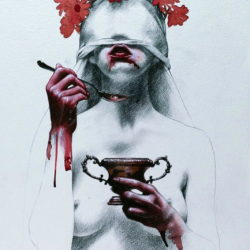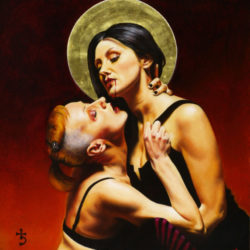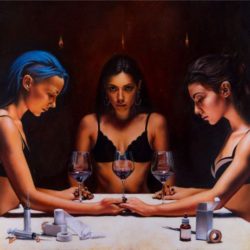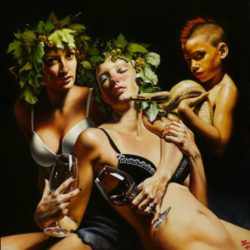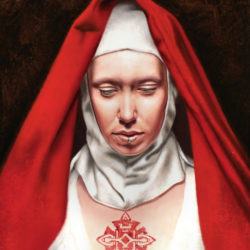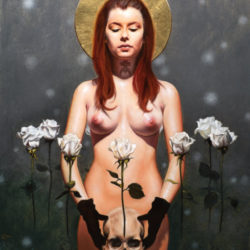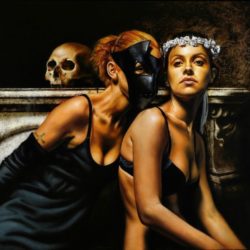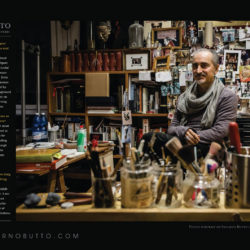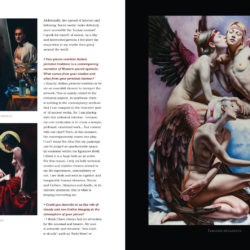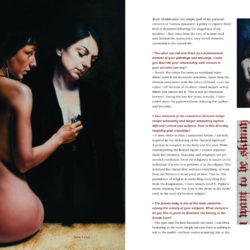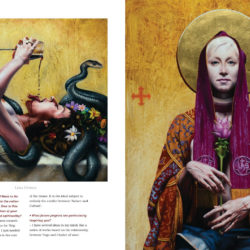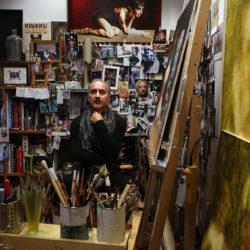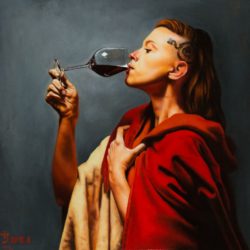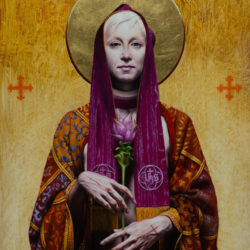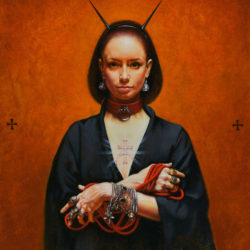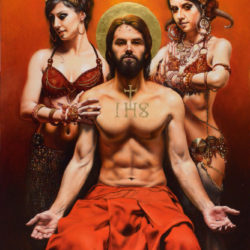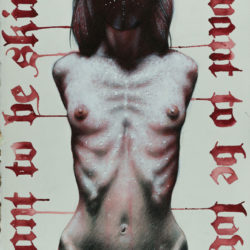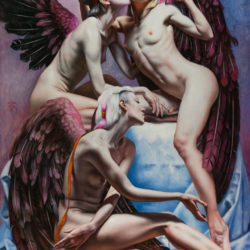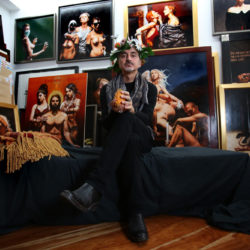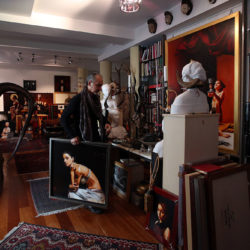Q: Could you describe the evolution of your pictorial style between byzantine icons and historical avant-garde?
A: I am not sure if it is possible to talk about ‘evolution’ in the style of my paintings. Apart from researching more sophisticated pictorial textures, technically speaking I have always been interested in bodies and portraits. Even today, I am loyal to my ‘first love’, the human figure. I keep interpreting it on one hand by taking inspiration from my cultural background (byzantine art and historical avant-garde); on the other, by everything I discover observing the world and the people surrounding me.
Q: Are you also inspired by other mediums to create your atmospheres and characters?
A: Connecting to what I said above, what most inspires me is the every-day life. All I need is to connect to people, who often will also be the models I am going to work with – finding infinite creative sparks. For me, it is enough to place a specific figure at the core of the composition to evoke the atmosphere I am looking for – aware of the ‘Western eye’ guiding my choices.
Q: Since 1993, you are exhibiting between Italy, Europe and US. How is travelling inspiring your work?
A: If I think about, I have been actually exhibiting my work more abroad than in Italy. I am not a traveller, however; and I’d rather not move too far from my homeland. Also, artistically speaking, I don’t feel the necessity of looking elsewhere for new creative stimulations. Additionally, the spread of Internet and following ‘Social media’ make definitely more accessible the ‘human contact’. I speak for myself, of course, as a shy and introverted person; I feel more the inspiration in my studio than going around the world.
Q: Your pieces combine Italian pictorial tradition to a contemporary narrative of Western sacred symbols. What comes from your studies and what from your personal interest?
A: Exactly. Italian pictorial tradition is for me an essential element to interpret the artwork. This is mainly related to the technical aspects. In synthesis: there is nothing in the contemporary medium that I can compare to the ‘evocative power’ of ancient works. So, I am playing with this technical solution – because my core motivation is to create a unique, profound, emotional work… but current with our time!! Then, at this moment, the contemporaneity comes into play. I can’t stand the idea that my paintings can be judged as anachronistic (popular comment within the figurative field); I think it is a huge limit as an artist. For this reason, I rely on both technical studies and stylistic choices related to my life experiences, contradictory or not. I see flesh and soul as together and inseparable human elements. Nature and Culture, Dionysus and Apollo, in its extreme synthesis; this is what is keeping interesting me.
Q: Could you describe to us the role of rituals and neo-Gothic imagery in the atmosphere of your pieces?
A: I think I have always had an attraction for the unusual and bizarre. My soul is romantic and decadent. ‘Neo-Gothic rituals’, such as ‘Sado-Maso’ or ‘Body-Modification’ are simply part of my personal research of ‘human dynamics’. I prefer to explore these kind of dynamics following the suggestion of my intuition – they come from the core of human soul and, behind the appearance, they reveal elements connected to the sacred life.
Q: You often use red and black as a fundamental element of your paintings and drawings. Could you describe your relationship with colours in your pictorial journey?
A: Surely, the colour becomes an emotional state where there is no decorative intention. Apart from the obvious association with the colour of blood, I use the colour ‘red’ because of its direct visual impact, acting where you cannot see it. This is not an obsession, however; during the last few years, actually, I have cooled down the palette without reducing the ‘pathos’ and intensity.
Q: Your research of the connection between body’s innate sensuality and deeper sensuality explore different context and subjects. How is this diversity inspiring your creativity?
A: It does relate to what I mentioned before. I am fully inspired by the dichotomy of the ‘Natural-Spiritual’. A person is complete in the body and the soul. While contemplating the human figure, I cannot separate these two elements. Sexuality and religiosity are primordial conditions. Even the religiosity is innate in the individual; if it ever is a problem, it is the religion. This is indeed the circuit that activates everything, at least from the Western culture point of view. That is, ‘the persistence of religion in controlling everything that feeds the imagination.’ I have always loved C. Paglia’s words claiming that ‘the Eros is the thorn in the flesh/stick in the mud of Christian religion’.
Q: The female body is one of the main elements among the variety of your subjects. What elements do you like to paint to illustrate the beauty in the female form?
A: The gaze and the face fascinate me most. I am often hesitating on the nude, simply because there is nothing to add to the model – without underestimating him or her.
Q: One of your last pieces is ‘I Want to Be Skinny/I Want to Be Loved’ for the collective exhibition STIGMATIZE. How is this work representing the evolution of your artistic research on body and spirituality?
A: The excessive model’s thinness immediately suggested to me the piece for ‘Stigmatize’. Anorexia is a stigma; I just needed it to explore these forms to go to the core of the theme. It is the ideal subject to embody the conflict between ‘Nature and Culture’.
Q: What future projects are particularly inspiring you?
A: I have several ideas in my mind, like a series of works based on the relationship between ‘Yoga and Chalice of wine’.



